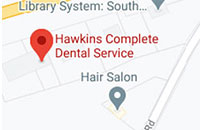At Hawkins Complete Dental Service, we use advanced treatment techniques to achieve the best possible outcomes for you and your family. For instance, you can get Leukocyte – Platelet Rich Fibrin (L-PRF™) therapy, a method of using your own blood to promote healing, following a tooth extraction or other oral surgery procedure.
Dr. Hawkins draws a small amount of blood, then uses a centrifuge to create a substance that promotes healing by “super-charging” your natural healing process when applied to the site of your procedure. It reduces your recovery time and lowers the incidence of possible complications like a painful dry socket.
You’ll feel better about your oral surgery if you know we’re doing all we can to shorten your recovery time! If you have any questions about your oral surgery, either before or after your procedure, call Hawkins Complete Dental Service at 740-214-1301.
What Is L-PRF and How Does It Work?
Let’s break down what is in L-PRF:
- Leukoctyes are white blood cells. Part of the immune system, they help heal your body.
- Both platelets and fibrin help create blood clots, which also promote healing.
After Dr. Hawkins uses your blood to create L-PRF and applies it to your extraction site, it releases healing proteins for up to two weeks, a period during which your body is working to heal itself. It’s not unlike the process that occurs when you cut yourself and your body creates a clot to stop the bleeding, forms a scab to protect the area, and grows healthy new skin. L-PRF boosts healing by concentrating your body’s healing properties and putting it right where your body needs it.
L-PRF is biocompatible, which means it involves no additives, chemicals, or other foreign substances. This lowers the risk of allergic reactions or other complications.
In addition to using L-PRF after removing a tooth, Dr. Hawkins can combine L-PRF with bone graft material to spur new bone growth. We often use this process to improve bone strength if your jawbone is too thin to support dental implants.
L-PRF therapy isn’t the only technological advance we’ll use for your oral surgery. Before your procedure begins, Dr. Hawkins uses digital X-rays to plan your procedure. Digital X-rays are faster than traditional X-rays, and Dr. Hawkins can also enlarge or sharpen the digital images to plan your procedure. If he finds potential complications such as impacted wisdom teeth, he may refer you to a specialist.
What Can You Do to Help the Healing Process?
While L-PRF will naturally encourage healing, you can do your part by following some best practices after your oral surgery. Right after your surgery, we’ll provide you with gauze to cover the extraction site. You’ll want to apply gentle but firm pressure on the site for at least 45 minutes. If gauze becomes saturated, change to a new piece of gauze.
If bleeding doesn’t seem to be slowing, you can try using a damp tea bag instead of the gauze. Choose black tea, the kind usually used to make iced tea. The tea’s tannic acid will encourage blood clots to form. Again, the L-PRF will promote clotting too.
Don’t brush or floss your teeth for 24 hours after your oral surgery. While you may be tempted to rinse out your mouth, you should avoid spitting and rinsing during that first day. After 24 hours have passed, you can resume brushing and flossing; be gentle and avoid the site of the extraction. Don’t use mouth rinses with alcohol. Use warm salt water to rinse, and avoid vigorous rinsing for at least a few days.
More Best Practices for Post-Surgery Care
Here are some other recommendations to minimize pain and encourage healing following oral surgery:
- Use ice packs to reduce swelling. Keep on the site for about 20 minutes, then rest for 20 minutes before reapplying. If swelling lasts longer than 24 hours, begin using warm towels instead of ice.
- If you get a prescription for pain relief medication, take it as directed. If not, we’ll probably recommend an over-the-counter product like ibuprofen (Advil or Motrin) or naproxen (Aleve).
- Don’t touch or poke your extraction site with your fingers or your tongue.
- Drink lots of water.
- Don’t consume solid foods for the first day. Yogurt, scrambled eggs, milkshakes, pudding, and soup (if lukewarm) are good choices. No spicy foods or acidic foods and beverages for a few days.
- Avoid causing changes in air pressure. So no smoking or drinking through a straw. If you need to blow your nose, do it gently.
If you’ve got any questions or concerns during your recovery, call our Zanesville, OH dentist office at 740-214-1301.
Call Today to Make an Appointment
We can see you as soon as tomorrow!


![What Is L-PRF Therapy and Why Do We Use It? [BLOG]](https://zanesvilleohdentist.com/wp-content/uploads/sites/25/2017/11/oral_surgery_3.jpg)


